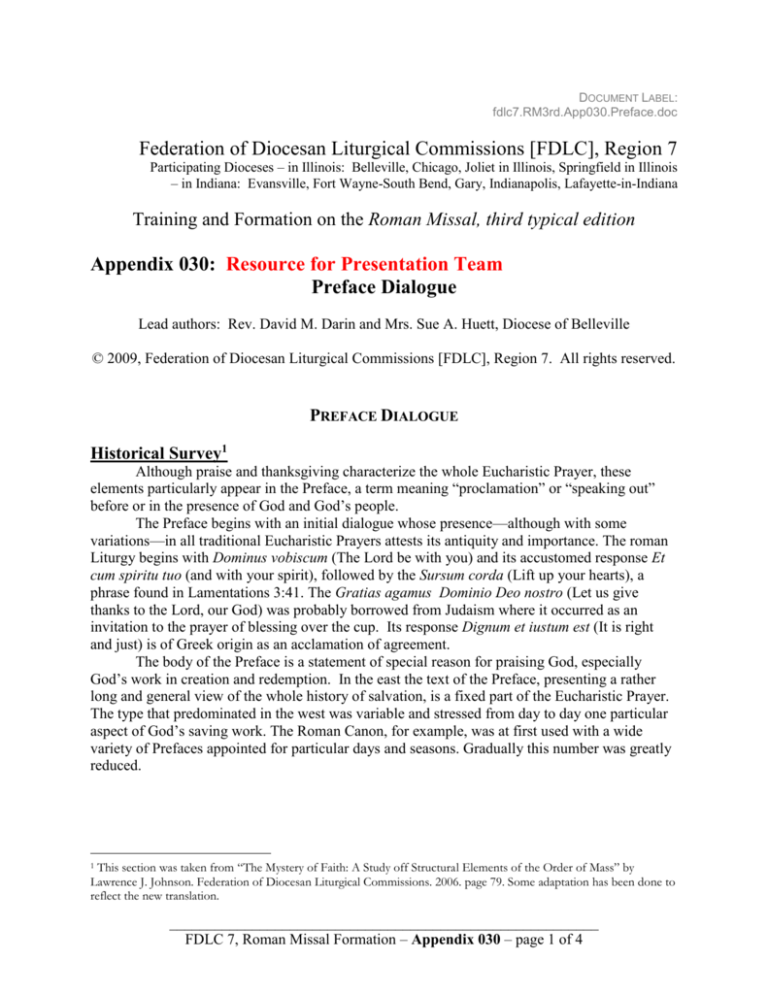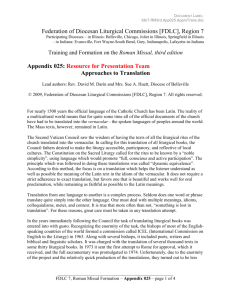
DOCUMENT LABEL:
fdlc7.RM3rd.App030.Preface.doc
Federation of Diocesan Liturgical Commissions [FDLC], Region 7
Participating Dioceses – in Illinois: Belleville, Chicago, Joliet in Illinois, Springfield in Illinois
– in Indiana: Evansville, Fort Wayne-South Bend, Gary, Indianapolis, Lafayette-in-Indiana
Training and Formation on the Roman Missal, third typical edition
Appendix 030: Resource for Presentation Team
Preface Dialogue
Lead authors: Rev. David M. Darin and Mrs. Sue A. Huett, Diocese of Belleville
© 2009, Federation of Diocesan Liturgical Commissions [FDLC], Region 7. All rights reserved.
PREFACE DIALOGUE
Historical Survey1
Although praise and thanksgiving characterize the whole Eucharistic Prayer, these
elements particularly appear in the Preface, a term meaning “proclamation” or “speaking out”
before or in the presence of God and God’s people.
The Preface begins with an initial dialogue whose presence—although with some
variations—in all traditional Eucharistic Prayers attests its antiquity and importance. The roman
Liturgy begins with Dominus vobiscum (The Lord be with you) and its accustomed response Et
cum spiritu tuo (and with your spirit), followed by the Sursum corda (Lift up your hearts), a
phrase found in Lamentations 3:41. The Gratias agamus Dominio Deo nostro (Let us give
thanks to the Lord, our God) was probably borrowed from Judaism where it occurred as an
invitation to the prayer of blessing over the cup. Its response Dignum et iustum est (It is right
and just) is of Greek origin as an acclamation of agreement.
The body of the Preface is a statement of special reason for praising God, especially
God’s work in creation and redemption. In the east the text of the Preface, presenting a rather
long and general view of the whole history of salvation, is a fixed part of the Eucharistic Prayer.
The type that predominated in the west was variable and stressed from day to day one particular
aspect of God’s saving work. The Roman Canon, for example, was at first used with a wide
variety of Prefaces appointed for particular days and seasons. Gradually this number was greatly
reduced.
This section was taken from “The Mystery of Faith: A Study off Structural Elements of the Order of Mass” by
Lawrence J. Johnson. Federation of Diocesan Liturgical Commissions. 2006. page 79. Some adaptation has been done to
reflect the new translation.
1
_________________________________________________________
FDLC 7, Roman Missal Formation – Appendix 030 – page 1 of 4
Notes on the New Translation of the Missale Romanum, editio typica tertia
(from the August 2005 Newsletter – © 2008 USCCB)
While there are many and complex elements of the translation yet to be decided by the Bishops,
the translation of several phrases in the Order of Mass have been previously decided by the
instruction Liturgiam authenticam. Among these are “certain expressions that belong to the
heritage of the whole or of a great part of the ancient Church, as well as others that have become
part of the general human patrimony…” Therefore, the response Et cum spiritu tuo is “to be
respected by a translation that is as literal as possible." Commentaries for a popular
understanding of these two elements of the Liturgy are provided here and may be reproduced
freely with the customary copyright acknowledgement by our readers.
“AND WITH YOUR SPIRIT”
Perhaps the most common dialogue in the Liturgy of the Roman Rite consists of the greeting :
Dominus vobiscum
et cum spiritu tuo
Since 1970, this has been translated as:
The Lord be with you.
And also with you.
As a part of the revised translation of the Roman Missal, now taking place, the translation of this
dialogue has been revised, to read:
The Lord be with you.
And with your spirit.
Latin Text
Dominus vobiscum.
Et cum spiritu tuo.
1970 Translation
The Lord be with you.
And also with you.
New Translation
The Lord be with you.
And with your spirit.
Since it is clear that the change to “and with your spirit” is a significant and wide ranging change
in a longstanding liturgical practice, the following questions are provided to clarify the reasons
for the change and the meaning of the dialogue itself.
1. Why has the response et cum spiritu tuo been translated as and with your spirit?
The retranslation was necessary because it is a more correct rendering of et cum spiritu tuo.
Recent scholarship has recognized the need for a more precise translation capable of expressing
the full meaning of the Latin text.
_________________________________________________________
FDLC 7, Roman Missal Formation – Appendix 030 – page 2 of 4
2. What about the other major languages? Do they have to change their translations?
No. English is the only major language of the Roman Rite which did not translate the word
spiritu. The Italian (E con il tuo spirito), French (Et avec votre esprit), Spanish (Y con tu
espíritu) and German (Und mit deinem Geiste) renderings of 1970 all translated the Latin word
spiritu precisely.
3. Has the Holy See ever addressed this question?
In 2001, the Congregation for Divine Worship and the Discipline of the Sacraments published an
instruction entitled, Liturgiam authenticam, subtitled, On the Use of Vernacular Languages in
the Publication of the Books of the Roman Liturgy. The instruction directs specifically that:
“Certain expressions that belong to the heritage of the whole or of a great part of the ancient
Church, as well as others that have become part of the general human patrimony, are to be
respected by a translation that is as literal as possible, as for example the words of the people’s
response Et cum spiritu tuo, or the expression mea culpa, mea culpa, mea maxima culpa in the
Act of Penance of the Order of Mass.”
4. Where does this dialogue come from?
The response et cum spiritu tuo is found in the Liturgies of both East and West, from the earliest
days of the Church. One of the first instances of its use is found in the Traditio Apostolica of
Saint Hippolytus, composed in Greek around AD 215.
5. How is this dialogue used in the Liturgy?
The dialogue is only used between the priest and the people, or exceptionally, between the
deacon and the people. The greeting is never used in the Roman Liturgy between a non-ordained
person and the gathered assembly.
6. Why does the priest mean when he says “The Lord be with you”?
By greeting the people with the words “The Lord be with you,” the priest expresses his desire
that the dynamic activity of God’s spirit be given to the people of God, enabling them to do the
work of transforming the world that God has entrusted to them.
7. What do the people mean when they respond “and with your spirit”?
The expression et cum spiritu tuo is only addressed to an ordained minister. Some scholars have
suggested that spiritu refers to the gift of the spirit he received at ordination. In their response,
the people assure the priest of the same divine assistance of God’s spirit and, more specifically,
help for the priest to use the charismatic gifts given to him in ordination and in so doing to fulfill
his prophetic function in the Church.
8. What further reading could you suggest on this dialogue?
For those who wish to pursue this issue from a more scholarly perspective, they might consult:
J.A. Jungmann, S.J., The Mass of the Roman Rite: its Origins and Development, trans.
F.A. Brunner C.Ss.R. (Westminster, MD: Christian Classics, 1986), 363.
Michael K. Magee, The Liturgical Translation of the Response “Et cum spiritu tuo”:
Communio 29 (Spring 2002) 152-171.
_________________________________________________________
FDLC 7, Roman Missal Formation – Appendix 030 – page 3 of 4
W.C. Van Unnik, “Dominus Vobiscum:” The Background of a Liturgical Formula:
A.J.B. Higgins (ed.), New Testament Essays (Manchester, University Press, 1959) 270305.
Material taken from The Mystery of Faith: A Study of the Structural Elements of the Order of the
Mass, revised edition © 2003, federation of Diocesan Liturgical Commissions (FDLC), 415
Michigan Avenue, NE, Suite 70, Washington, D.C. 20017. www.fdlc.org. Used with permission.
_________________________________________________________
FDLC 7, Roman Missal Formation – Appendix 030 – page 4 of 4








